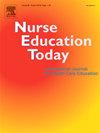护生医学人工智能准备程度与个人创新水平的关系调查
IF 3.6
2区 医学
Q1 EDUCATION, SCIENTIFIC DISCIPLINES
引用次数: 0
摘要
目的本研究旨在识别护生的医学人工智能准备程度和个人创新水平,检验这两个概念之间的关系,并确定产生显著差异的变量。方法采用描述性和相关性设计。本研究的样本包括来自伊斯坦布尔省两所不同大学的本科护理学生,两所大学都关注相似的教育目标(n = 386)。数据是在2024年3月至5月期间通过涉及“学生信息表”、“医疗人工智能准备量表”和“个人创新量表”的调查问卷收集的。采用描述性统计方法、t检验、方差分析和Pearson相关检验对资料进行分析。结果学生平均年龄为21.78±1.84岁(18-35岁),女性占78.8%,二、三年级学生占35.5%。学生在医学人工智能准备度量表上的平均得分为69.36±12.92,在个人创新能力量表上的平均得分为52.92±7.37。此外,性别、家庭结构、收入状况、自愿选择护理部门、关注该领域的科学/技术发展、接受过人工智能培训、了解人工智能在卫生领域和护理领域的应用、参加过创新培训/研讨会,被确定为影响医疗人工智能准备情况和个人创新的有效变量。医学人工智能准备程度量表和个人创新能力量表的平均总分和分量表得分呈显著正相关(p <;0.05)。结论护生医学人工智能准备水平高于平均水平,个人创新水平较低。研究发现,随着学生医学人工智能准备水平的提高,他们的个人创新水平也随之提高。尽管准备程度的提高提高了个人创新水平,但有前途的实践应该融入教育中,以获得更高级的关系和更高的分数。本文章由计算机程序翻译,如有差异,请以英文原文为准。
Investigation of the relationship between medical artificial intelligence readiness and individual innovativeness levels in nursing students
Aim
This study was conducted to identify nursing students' medical artificial intelligence readiness and individual innovativeness levels, to examine the relationship between these two concepts and to determine the variables that create a significant difference.
Methods
A descriptive and correlational design was employed. The sample of the study consisted of undergraduate nursing students from two different universities in Istanbul province, both of which focus on similar educational goals (n = 386). Data were collected between March and May 2024 using a questionnaire involving a “Student Information Form,” the “Medical Artificial Intelligence Readiness Scale,” and the “Individual Innovativeness Scale.” Descriptive statistical methods, t-test, ANOVA, and Pearson correlation test were used to analyze the data.
Results
The mean age of the students was 21.78 ± 1.84 years (18–35), 78.8 % were female, and 35.5 % were 2nd- and 3rd-year students. The students' mean score was 69.36 ± 12.92 on the total Medical Artificial Intelligence Readiness Scale and 52.92 ± 7.37 on the total Individual Innovativeness Scale. In addition, gender, family structure, income status, choosing the nursing department willingly, following scientific/technological developments in the field, having received training in artificial intelligence, having knowledge about the use of artificial intelligence in the health field and nursing, and having attended training/seminars on innovation were determined to be effective variables on Medical Artificial Intelligence Readiness and Individual Innovation. There was a significant positive relationship between the mean total and subscale scores on the Medical Artificial Intelligence Readiness Scale and the Individual Innovativeness Scale (p < 0.05).
Conclusion
Nursing students' medical artificial intelligence readiness levels were above average, and their individual innovativeness levels were low. It was found that as the students' medical artificial intelligence readiness levels increased, their individual innovativeness levels increased, as well. Although increased readiness levels boost the level of individual innovation, promising practices should be integrated into education for more advanced relationships and higher scores.
求助全文
通过发布文献求助,成功后即可免费获取论文全文。
去求助
来源期刊

Nurse Education Today
医学-护理
CiteScore
6.90
自引率
12.80%
发文量
349
审稿时长
58 days
期刊介绍:
Nurse Education Today is the leading international journal providing a forum for the publication of high quality original research, review and debate in the discussion of nursing, midwifery and interprofessional health care education, publishing papers which contribute to the advancement of educational theory and pedagogy that support the evidence-based practice for educationalists worldwide. The journal stimulates and values critical scholarly debate on issues that have strategic relevance for leaders of health care education.
The journal publishes the highest quality scholarly contributions reflecting the diversity of people, health and education systems worldwide, by publishing research that employs rigorous methodology as well as by publishing papers that highlight the theoretical underpinnings of education and systems globally. The journal will publish papers that show depth, rigour, originality and high standards of presentation, in particular, work that is original, analytical and constructively critical of both previous work and current initiatives.
Authors are invited to submit original research, systematic and scholarly reviews, and critical papers which will stimulate debate on research, policy, theory or philosophy of nursing and related health care education, and which will meet and develop the journal''s high academic and ethical standards.
 求助内容:
求助内容: 应助结果提醒方式:
应助结果提醒方式:


